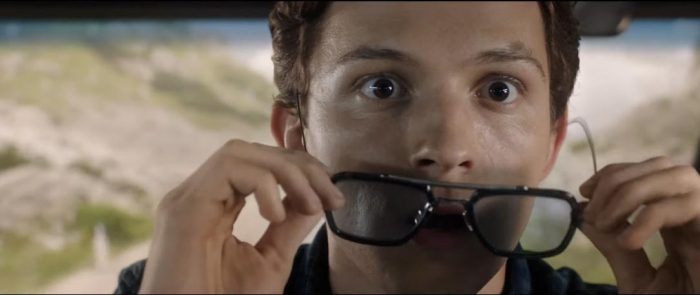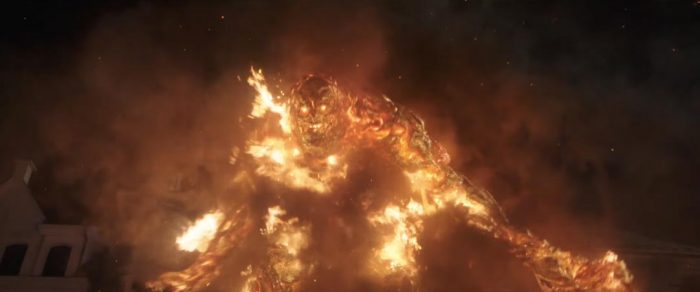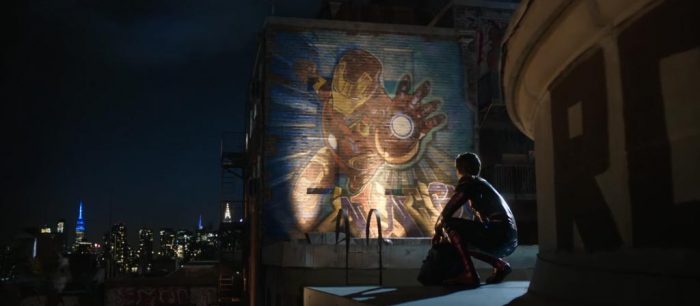‘Spider-Man: Far from Home’ Spoiler Review: With Great Power Comes a Villain Made For Our Troubled Times

In his novel White Noise, which won the National Book Award, Don DeLillo famously wrote of an “Airborne Toxic Event.” It almost sounds like a plot device from a superhero blockbuster. Think: Suicide Squad’s self-conscious recognition of the “swirling ring of trash in the sky” trope. The weakest part, visually, of Spider-Man: Far from Home — an otherwise super-enjoyable romp through the post-Endgame MCU — is its CG “Elementals.” These were glimpsed in trailers so it’s no big spoiler to say they’re part of the movie or that one of them does internally swirl in a ring-like formation.
What’s interesting about the Elementals is that they’re loosely based on Marvel Comics villains yet their function in Far from Home, beyond the obvious spectacle, is largely symbolic. Full of sound and fury, signifying something, they’re the superhero blockbuster equivalent of a tweetstorm. Cross-reference: DeLillo’s Airborne Toxic Event. Notwithstanding the recent victory of Thanos, the Marvel Cinematic Universe has struggled in some ways to bring to life its supervillains with as much panache as its heroes. In this one respect, the intellectual-property farm of Marvel Comics has never quite enjoyed its full harvesting potential for Marvel Studios.
Not to worry: Tom Holland’s Spider-Man is now batting 2-for-2, villain-wise, in his solo movie adventures. The media loves a good scene-chewing villain: can we agree on that? Rather than argue politics in a superhero movie review, let’s objectively consider the idea of an attention-grabbing public figure who consistently “cuts through all the static” — vast, continental clouds of white noise — to make sensational headlines. Is he the anointed one, this man? Can he be trusted with ultimate power? To talk about that, we’ll need to get busy with some spoilers for Spider-Man: Far from Home.
The MCU, Phase Three, Season Finale
It wasn’t always clear why Phase Three of the MCU would be ending with Far from Home. The way Ant-Man was tacked onto the end of Phase Two made it seem like the delineation between phases was rather arbitrary. Now that Far from Home is in theaters, it’s easy to see why Phase Three is wrapping up with this movie instead of the big climax of Avengers: Endgame.
In the same way that serialized television dramas like the recently ended Game of Thrones have often followed the model of letting the big stuff go down in the penultimate episode of the season, the MCU packed the penultimate film of Phase Three with the death of Iron Man and Black Widow and the expedited aging of Captain America. All three of these characters are memorialized at the beginning of Far From Home in a cutely awkward high school video set to the tune of Whitney Houston’s “I Will Always Love You.”
Holland’s millennial version of Peter Parker would probably lump The Bodyguard, the 1993 film in which Houston’s rendition of the song first appeared, together with The Empire Strikes Back as one of those “really old movies.” This is especially true since, in case anyone’s forgotten, it’s 2023 now in the MCU. Five years passed between the Snap, when half the world turned to dust at the end of Infinity War, and the newly labeled “Blip,” when half the world blinked back into existence in Endgame.
Some of Peter’s high school classmates are shown blipping onto the basketball court in the middle of a game. Others have to face the fact that their younger siblings are now older than them. Conveniently, key supporting cast members such as Peter’s best friend, Ned Leeds (Jacob Batalon), his love interest, MJ (Zendaya), Ned’s own overnight plane girlfriend, Betty Brant (Angourie Rice), and even the rich bully, Flash Thompson (Tony Revolori) were all among the disappeared during the Snapture, so they haven’t aged much since we last saw them in Spider-Man: Homecoming.
To be sure, Endgame left the next MCU film with a good deal of housekeeping to do. Far from Home handles the “Five years later …” aspect with deft humor, like the moment when we see that Flash has been using the birth year on his old, pre-Snap I.D. to buy alcohol on the plane to Venice. He’s 16, not 21.
As it turns out, Far from Home is very much one of those epilogue-like season finales that you see on premium TV channels. It’s a coda to Endgame, one that deals with the aftermath of that film and the overarching Phase One to Phase Three Iron Man narrative, but in a personal way, as Peter grapples with Tony Stark’s legacy on his own young life.
Tony is a big posthumous presence in this movie. Murals of him decorate the walls of buildings in New York, and on the plane to Venice, Peter’s choice of inflight entertainment includes Heart of Iron: The Tony Stark Story. Before the closing credits roll, we’ll also see a nightmare vision of Tony’s zombified Iron Man suit come crawling up out of the grave to terrorize Peter during a hologram attack.
Yet over and above the Endgame epiloguing and Iron Man eulogizing, Far from Home also makes some unexpected callbacks to other MCU films. From a thematic standpoint, this is where things start to get really interesting …

B.A.R.F.-Induced Holograms
Fools that we are, there are those of us who trusted Endgame co-director Joe Russo back in January 2018 when he seemingly debunked the idea of there being time travel in his upcoming mega-sequel (then known only as Avengers 4). To throw fans off the scent of some leaked set photos, Russo gave a fine bit of misdirection about the possible return of B.A.R.F., the Binarily Augmented Retro-Framing technology that showed us a baby-faced double of Robert Downey, Jr. in Captain America: Civil War.
At the time, Russo said that technology “was laid in for a very specific reason.” He wasn’t lying; he was just engaging in some smoke and mirrors, not unlike the real villain of Far from Home, the guy who controls the holographic Elementals.
As we all know, Endgame did feature time travel. Lo and behold, it’s Far from Home that picks up the discarded plot point of B.A.R.F. and makes good use of it to show how some disgruntled ex-employees of Stark Industries (including one bald, bespectacled Arc Reactor scientist who we last saw Obadiah Stane haranguing all the way back in Iron Man) have formed a tech team around a very irresponsible, headline-chasing illusions specialist.
Going into this Fourth of July in the year of our Lord 2019, it’s easy to see a famous egotistical shadow hovering in the background of Far from Home. It’s not necessarily, at all times, the shadow of Tony Stark, either.
A few months ago, when revisiting Unbreakable — another superhero film co-starring Samuel L. Jackson, which was years ahead of its time — I wrote about how that film put forth the idea that comic books (and by extension, comic book movies) are a form of history. They absorb cultural patterns and even perhaps patterns in the collective unconscious that have yet to fully emerge in the culture at large.
In 1978, the prototypical comic book movie, Superman, introduced theatergoers to Lex Luthor, a big-city businessman with sketchy hair whose elaborate, nuke-inflected real estate schemes brought him into conflict with Clark Kent/Superman, a newspaper reporter and illegal alien (literally an extraterrestrial who rocketed to Kansas without a green card and lived there in hiding). Fast forward to 2000 and DC Comics would depict Lex Luthor running for President … and winning. Our current real-life President had ended his first campaign prematurely that year, but now he’s in the White House and the media and immigrants are his arch-enemies.
The point, which should be fairly obvious by now, is that comic books and comic book movies hold the secrets of the universe. One benefit of the MCU’s serialized brand of big-screen storytelling is that it allows this fictional shared universe we’re all watching to thread itself together more and more as it goes along. In the long run, viewers will have more of an appreciation for certain things once they see the full pattern, as it gradually takes shape over the course of multiple movies.
An unimpressed viewer might see the Elementals in Far from Home as barf-inducing CG constructs, bipedal puddles of molten goo, but in fact, they are holographic projections induced by a drone-based offshoot of the B.A.R.F. technology. When Spider-Man swings his way inside one, we see how the drones swirl in a ring to create a Whirlwind, city-attacking lie. They’re an Airborne Toxic Event unleashed by the wanton Quentin Beck (Jake Gyllenhaal), who believes that “more casualties” equals “more coverage.”
In his review of Far from Home, film critic David Ehlrich alluded to a villain “bellowing some half-baked Trumpian garbage about how easy it is to fool people who are already fooling themselves.” I don’t think Mysterio is half-baked. I think he’s quite fully baked in a delicious way.
I would really need to sit down and think hard about who my favorite MCU villains are (there are enough good ones for at least a Top 5), but I can tell you right now that Mysterio would have an immediate ranking on whatever list I might draft up. This is not because of any affinity for what he represents; it’s more because he, like Thanos, the living embodiment of death in the MCU, does have some subtextual meat on his bones and Gyllenhaal’s performance sells it in such a gleefully entertaining way.
Continue Reading Spider-Man: Far From Home >>
The post ‘Spider-Man: Far from Home’ Spoiler Review: With Great Power Comes a Villain Made For Our Troubled Times appeared first on /Film.
from /Film https://ift.tt/2xuBpKN

No comments: